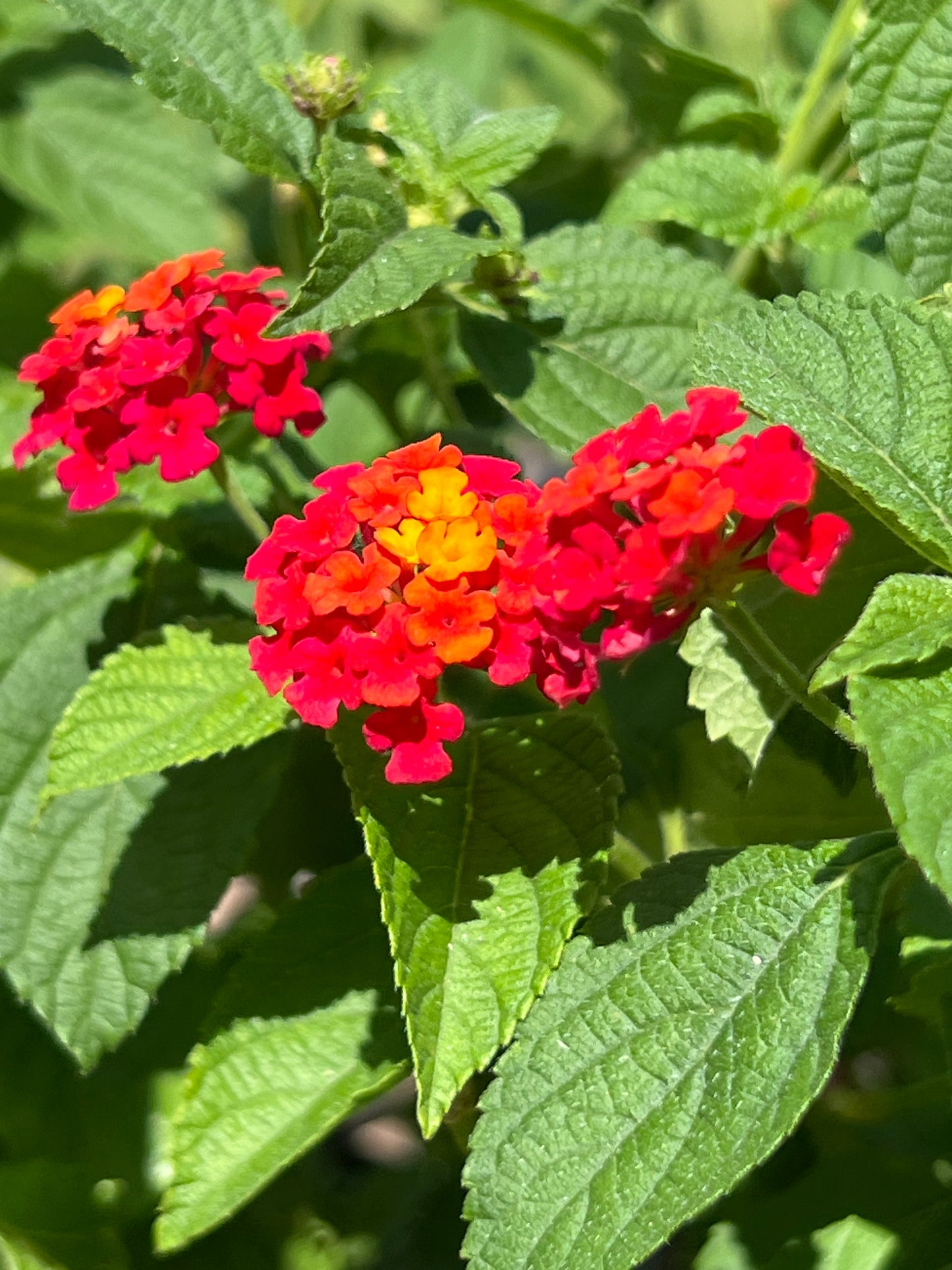Lantana - Red
Lantana - Red
Lantana is a versatile and vibrant flowering plant known for its clusters of small, brightly colored flowers. The flowers can come in a variety of shades, including red, orange, yellow, pink, purple, and white, often changing colors as they age, creating a multi-colored effect on each flower cluster. The plant has a bushy growth habit with rough, dark green leaves that emit a distinct aroma when crushed. Lantana is a member of the Verbenaceae family and is popular for its long blooming period, often from spring until the first frost.
Grow Zone:
- USDA Hardiness Zones: 8-11
Height and Width:
- Height: Typically grows 1 to 6 feet (30 cm to 1.8 meters) tall, depending on the variety and growing conditions.
- Width: Can spread 3 to 10 feet (90 cm to 3 meters) wide, depending on the variety.
Growing Requirements:
- Light: Prefers full sun for the best flowering. Lantana can tolerate some partial shade, but flowering may be reduced.
- Water: Drought-tolerant once established, but prefers regular watering, especially in the hottest part of summer. Allow the soil to dry out between waterings.
- Soil: Thrives in well-draining soil and is tolerant of a wide range of soil types, including sandy, loamy, and even slightly rocky soils. It prefers slightly acidic to neutral pH.
- Temperature: Enjoys warm temperatures and thrives in hot, sunny climates. It is frost-sensitive, so it should be protected or moved indoors if temperatures drop below 32°F (0°C).
- Fertilization: Lantana doesn’t require heavy fertilization. A light application of a balanced fertilizer in spring can help boost growth and flowering, but over-fertilizing can reduce blooms.
- Pruning: Prune lantana in late winter or early spring to remove dead wood and shape the plant. Light pruning throughout the growing season can encourage a bushier growth habit and more flowers.
Uses:
- Ornamental: Lantana is popular in gardens and landscapes for its colorful and long-lasting flowers, making it ideal for borders, beds, and as a ground cover.
- Container Gardening: It grows well in pots and hanging baskets, where it can trail or cascade over the sides.
- Pollinator Gardens: The flowers attract butterflies, bees, and hummingbirds, making lantana an excellent choice for pollinator-friendly gardens.
- Erosion Control: Due to its spreading habit, it can be used for erosion control on slopes and embankments.
- Hedges and Borders: Some varieties are suitable for creating low hedges or edging plants in garden beds.
Native Range:
Lantana is native to tropical regions of the Americas, particularly Central and South America. It has naturalized in many warm regions around the world, including parts of Africa, Australia, and the southern United States.
Lantana is appreciated for its resilience, vibrant colors, and ability to attract pollinators. With proper care, it can be a lively addition to both garden landscapes and container displays.
---SHIPPING NOTICE PLEASE READ BEFORE PURCHASING LIVE PLANTS!---
We WILL NOT refund the purchase of or the shipping cost of live plants purchased with the intent to be shipped to states that do not authorize importing live plants or to states with restrictions! Purchases to these states will be held for 30 days for pick-up at our Slidell, Louisiana store and the shipping cost associated with these purchases will be held for the care of the plant while waiting to be picked up. All sales are final. If the plant(s) purchased are not picked up within 30 days from the date of order, these items will be returned to our sales inventory and you WILL NOT be refunded. Thank you for understanding these policies.
Due to regulations, certain states have restrictions on importing plants. Please review the list below to ensure you're not attempting to order any restricted plants in your area.
**Important Note:** We do not ship any plants outside the U.S.
State-Specific Restrictions - We ARE NOT responsible for any plant(s) that are not listed in these restrictions. Purchaser bears all responsibility for making sure the plant(s) they desire to purchase are not banned from being imported to the shipping state:
Arizona: Juglans spp.
California: Castanea spp., Juglans spp., Pinus spp., Quercus spp.
Colorado: Some counties restrict Prunus spp. Please verify your local county regulations.
Florida: Castanea spp., Cornus spp., Quercus spp., Cornus mas
Georgia: Vaccinium spp.
Hawaii: Pinus spp.
Idaho: Humulus lupulus, Mentha spp., Vitis spp.
Indiana: Fragraria spp., Rosa spp.
Kansas: Juglans spp.
Michigan: Abies spp., Vaccinium spp.
Montana: Pinus spp.
Nevada: Allium spp.
Mentha spp.
New Jersey: Rosa spp.
New York: Vitis spp.
Oregon: Allium spp., Castanea spp., Corylus spp., Humulus lupulus, Quercus spp., Sambucus nigra, Ulmus spp., Vaccinium spp., Vitis spp.
Texas: Juglans spp.
Washington: Allium spp., Castanea spp., Corylus spp., Humulus lupulus, Vaccinium spp., Vitis spp.
Wisconsin: Abies spp., Pinus spp., Picea spp., Mentha spp.
Additionally, we cannot ship plants in soil medium to the following states: AK, AL, AR, AZ, CA, HI, ID, KS, MS, MT, ND, NM, NV, OK, OR, SD, TX, UT, WA.
Couldn't load pickup availability


